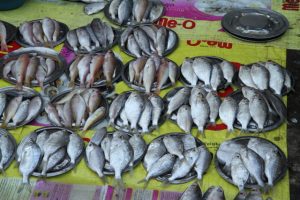Escolar (Lepidocybium flavobrunneum) and oilfish (Ruvettus pretiosus) have been responsible for a number of food poisoning outbreaks involving a type of oily diarrhoea, called keriorrhoea. For example, investigation of some Australian outbreaks of oily diarrhoea suggest between 45 and 67 per cent of people may become ill after eating these fish species. There is probably a significant under-reporting of illness associated with the consumption of these fish as the symptoms can be mild and short-lived.The oily diarrhoea is caused by indigestible oil contained in these fish, which accumulates in the rectum before being expelled. Symptoms range from an oily orange or yellow discharge, to severe diarrhoea with nausea and vomiting. Other symptoms may include stomach cramps, loose bowel movements and headache. The symptoms can occur without warning, usually within 2 ½ hours of consumption, but range from 1 to 90 hours later. Unlike other forms of diarrhoea, the oily diarrhoea caused by these fish does not cause significant loss of body fluid and is not life-threatening. Symptoms may last for one or two days.
If you are pregnant, have a bowel problem or malabsorption, you are advised not to consume these fish. If you are eating these fish for the first time, consume only a small portion. If you experience gastrointestinal symptoms after eating this fish, do not consume this fish in future and seek medical advice if symptoms persist.
Fish: naturally occurring mercury. Fish is great for your health and everyone should eat two to three serves of fish a week for good health. However, some of the larger species of fish, such as shark, marlin and swordfish, have levels of naturally occurring mercury. These species can build up levels of mercury because they are predatory and eat smaller fish and they also live a long time absorbing mercury from the ocean.
The effects in babies exposed to high levels of mercury in the womb can include lower scores on tests that measure attention, learning and memory in their early years. Pregnant women, women planning pregnancy and young children shouldn’t eat shark, broadbill, marlin and swordfish more than once a fortnight, with no other fish eaten that fortnight. They also shouldn’t eat orange roughy (also sold as sea perch) and catfish, more than once a week, with no other fish eaten during that week.
The general population should eat only one serve per week of Shark (Flake) or Billfish (Swordfish / Broadbill and Marlin) and no other fish that week. Check the mercury in fish advice from Food Standards Australia New Zealand.
There are plenty of other types of fish to choose for your two to three serves a week. Check with your fish retailer about the type of fish you are buying or check the ingredient list on a package or can.
Ciguatera food poisoning is an unusual form of food poisoning most typically caused by larger and older fish that live in warm ocean waters. However smaller warm ocean water finfish may also be implicated. The poisoning is caused by people eating fish containing the ciguatera toxin. The contaminated fish have eaten smaller fish that eats the algae that shelters a tiny organism responsible for producing a toxin that causes ciguatera.
Within 24 hours symptoms emerge including numbness around the fingers, toes and mouth, a burning sensation when in contact with cold, joint pain, nausea, itchiness and for people with high sensitivity, breathing difficulties. Problems may be encountered with eating coral trout, spanish mackerel, reef cod, barracuda, emperor, groper, sturgeon, trevally and kingfish. Any warm water predatory fish over 6 kg should be treated with suspicion. Under no circumstances should the head, roe or liver be eaten, and it is wise to eat a small portion of any large fish to test for reactions 24 hours before serving. If you develop symptoms seek medical advice.
Scombroid or histamine poisoning is the result of inadequate temperature control of fish. It can occur when fish that has not been chilled to 4°C or below is eaten. The result is a high level of histamine building up in the fish flesh. Often misdiagnosed as an allergic reaction, symptoms vary but include:
- burning and tingling of the lips and mouth
- dizziness
- flushing of the face
- an itchy rash, often on the face, neck, chest and upper back
- sweating
- vomiting and diarrhoea
- headaches
- blurred vision
- palpitations.
In severe cases, and particularly in those suffering from asthma, bronchial difficulties can occur.
Usually not of major concern, deaths overseas have focused attention on Scombroid poisoning.
See more about Natural toxins in food

